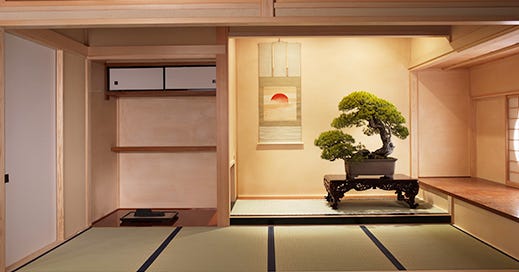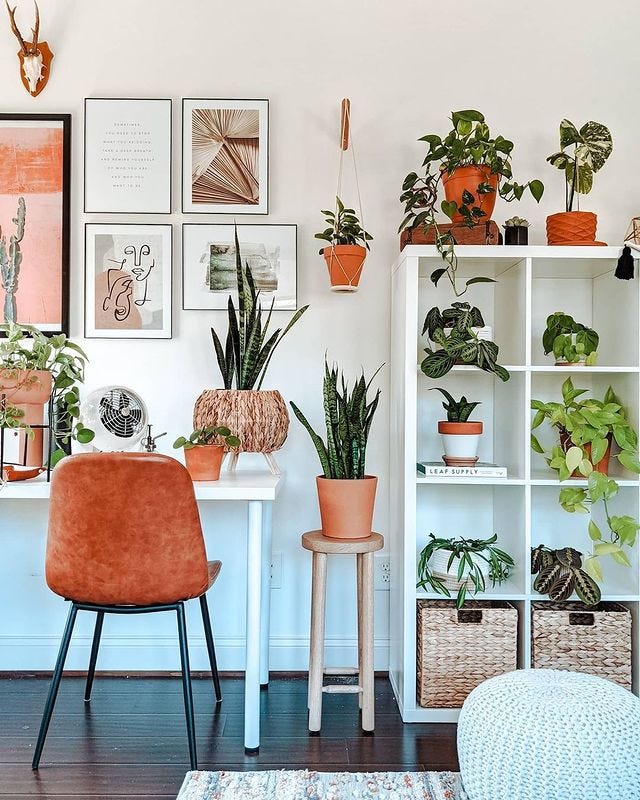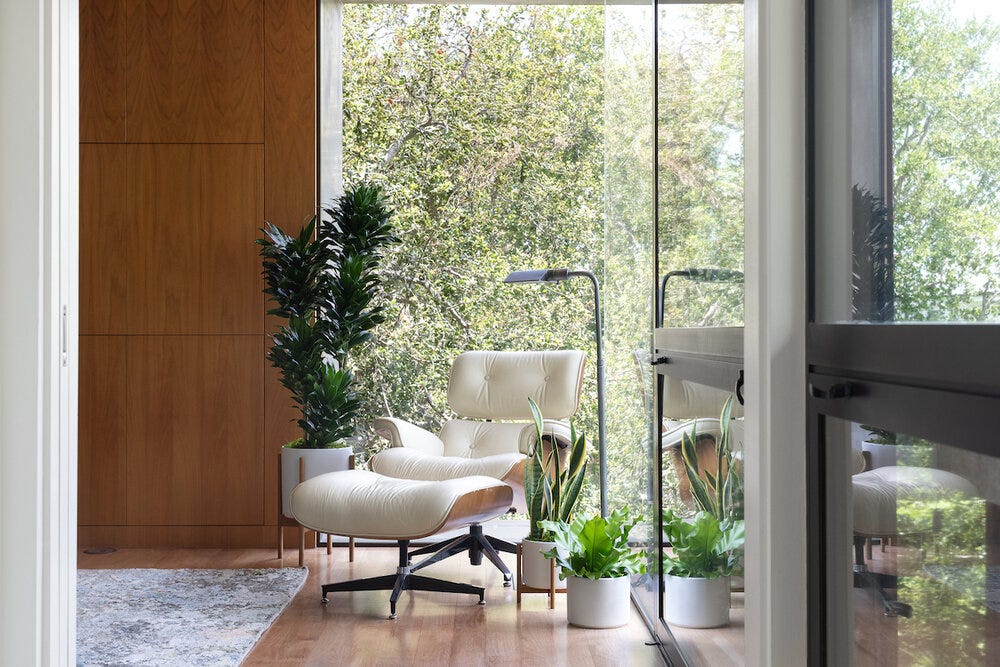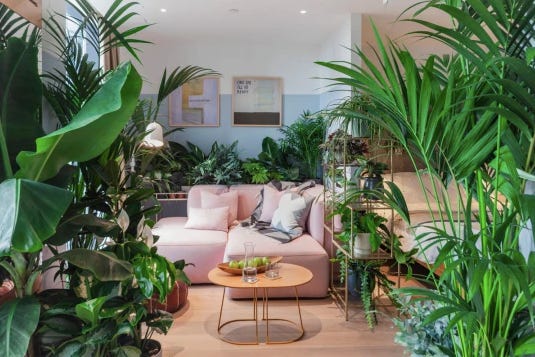“A house is just a pile of stuff with a cover on it." — George Carlin
Behold the indoor plant. Calm. Dignified. Serene. Beautiful. The juxtaposition of this tranquil display versus the ‘noise’ of the contemporary urban-plant jungle is, well, striking.1
But is it simply a question of calm versus clutter? The calculus of how many plants to have, which ones, and how we best display them, is largely a matter of personal choice — there are no rights or wrongs. Which is not to say, however, that we’re all interior-design experts on the matter, or happiness researchers, with nothing to learn. Maybe with a bit more info, and a little encouragement, great gains in our houseplant relationships could be made.
As they say, if you know where you’re going, you’re more likely to get there. I knew someone several years ago who spent a small fortune on plants and pots over a relatively short time only to just give it all up a year later. There was no family emergency or loss of a job. The house didn’t burn down. It just wasn’t working out. Clearly, whatever this person was hoping to achieve in becoming a plant collector, it never transpired.
The question is not houseplants, for or against, but rather how can we bring them into our lives in the most harmonious way, a way that maximises the benefits — aesthetic and psychological — while minimising the costs.
“It's the tide. It's the dismal tide. It's not the one thing.” ― Cormac McCarthy
First Came One, Then More
The other day I read an article online describing how clutter negatively impacts people’s well-being and their family relationships. Apparently there’s a lot of research on this. What surprised me in the article was how it bemoaned clutter and then offered up the idea of buying houseplants to connect with nature. Go on, add some green to that clutter! Never did it occur to the writer, it seems, that houseplants might swell the already-existing clutter, making matters worse.
Is it not, after all, a key attribute of clutter that it sneaks up on you. It’s not the one, but the many. Far from being immune to this process, indoor plants seem to be among the worst (at the time of writing this, the Instagram hashtag “plantaddict” had 2.2 million posts). 🙃 Houseplants positively love company — the company, that is, of more indoor plants. Woe to the parent of the teenage plant lover. No longer do they have just to deal with the usual, cluttered entropy of a child’s bedroom, now there’s a tropical garden in there too. What do you get when you cross a live poodle with a doll collection: houseplants.
If we enjoy being surrounded by delicate foliage and tropical treats, it behooves us to go forward with caution. Soon a jungle may appear before us, and all dangers contained within.
During the second Auckland (NZ) lockdown, I built myself a proper shade-house, much larger than the runt of a glasshouse pictured below (my first), both in terms of floor space and height. As I built the new structure, I imagined having plenty of room to roam, maybe even a table where, instead of moving, I could actually sit and relax. I could marvel at individual plants and ply my trade. I didn’t imagine clutter at all — it would be my own botanical garden, indeed, my own Wintergarden.
Fast forward a year later and you could literally measure my blood-pressure rising as I entered the shade-house, overwhelmed not just by the utter volume of indoor-plant life (and the Singaporean humidity), but also the task of having so many mouths to care for. Who was I kidding, I sell plants, I don’t dwell among them, basking in their glow, watching them photosynthesise. It was all I could do just to keep enough of a path that I could get a hose in there.
See what I mean, with potted plants, it’s easy get carried away. All those Instagram hashtags like #indoorjungle might be on to something, as though sometimes we’re trying to fulfil an ancient evolutionary urge to bring soft, natural landscapes into our hard, artificial confines.
Certainly the Instagram celebrity Hilton Carter thinks so. An article from the BBC writes… “The love of plants ‘grabbed’ Carter suddenly several years ago, and he ‘went from 10 plants to 50 or 60 plants within a few months.’ He soon transformed his home into an ‘indoor jungle’ he says with a laugh – a situation that his long-suffering wife has now accepted.”
The BBC article, “Why living with and tending plants is good for you,” emphasises the benefits of actively engaging with plants indoors, much as a traditional gardener would do so outdoors. As Baltimore-based Hilton Carter describes it, it’s like “having this living thing in your home, making you focus on the daily caring of something that you’re now bonded to. There’s something in the caring process that’s therapeutic, you can use it to meditate or escape, and for two hours once a week completely zone out.“ The article concludes… “City living has led to a disconnection with nature - houseplants are a way to re-connect with it.“
This is the hype of the indoor plant craze: you can never have enough of the tropics indoors, and the rarer or more exotic the better. To be sure, for some, these connections are real and enduring, with few downsides. For many others, however, bringing a garden indoors poses new and unanswered questions.
The Instagram caption for the post above: “Sometimes, more is more!” Indeed.
We often think of Victorian times as an historical example of the perennial love of having the outdoors indoors. This is true, but what about an entire indoor jungle? Until quite recently, aside from the plant conservatory, indoor plants were restricted to complementing the domestic environs, they didn’t define them, or overwhelm them. With few exceptions, plants were furnishings, not collections unto themselves. Which brings us to an important point: as plants become endemic to indoor landscapes, perhaps we would benefit from a more formal understanding of this relationship — something like house/plant ecology.

Interior Plants and the Mental Environment
Ecology is a useful word because it puts an emphasis on relationship. It’s not you or your plants, it’s your relationship with them. I remember as a university student learning that, when given a plant to nurture, seniors in elder-care homes coped better and lived longer. I doubt, however, anyone considered giving them thirty plants!
We like our indoor plants because of their aesthetic charms, but also because we form a care-giving relationship with them. It is this combination of attributes that makes them somewhat unique in the household. But as Hilton Carter warns: “If you get a ton of plants, not knowing how to care for them, you end up very sad, and wasting a lot of money.” Ultimately, it boils down to this: do we benefit from our relationship with plants, and how might we improve this relationship?
When I moved into a smaller house a year ago, I was confronted with the issue of how, or not, to display things to avoid clutter. It was not long before I noticed how, even putting plants aside, clutter seemed to close in very quickly. Objects that looked nice by themselves quickly diminished in their appeal as other objects crowded along beside them (hardly a new phenomenon). Indeed, clutter might be defined along these lines, as the moment when isolated objects accumulate to the point that their individual value is diminished, and eventually lost. It’s often said that decluttering means keeping what’s meaningful and getting rid of the rest. This misses the point, somewhat, in that what’s meaningful is no more a fixed attribute than it is a relational one.
Consider the bonsai tree shown at the start. It is magnificent in its isolation. Placing another bonsai beside it could only diminish its appearance, no matter what their merits. Indeed, when bonsai trees are displayed in professional gatherings, they are always essentially walled off in this manner, so they don’t have to share the scene with others.
In the house-scape this is an option, but again, it’s a question of taste. Clearly, many of us find that, rather, “more is more.” People differ, and where you cross the line from calm to chaos is a matter of taste. Studies show something like this too, where the stress caused by a cluttered environment begins at the point when, for that person, things feel cluttered.
In the example above, you can see a clear anti-clutter approach. Notice how everything has its own distinct space, without overlap, quite the opposite of the jungle aesthetic. The style works by allowing each plant to shine individually, not the jungle-scape where everything melds into a green collage. Those who enjoy this style (defined as ‘formal’ below), see it as clean, tidy, and chaos-free. Those who prefer the latter will scoff at the domestication, at the attempt to remove plants from nature and turn them into just more household objects.
Whatever the preference, I think it’s clear that as we go from one to many plants, there is an escalation in their emotional impact, whether positive or negative. There are, after all, millions of Instagram posts showing plants in interior spaces. While we might be ‘plant blind’ in the outdoors, paying little attention to the nature around us, we’re nevertheless obsessed with potted plants indoors.
How all this plays out in the future is an open question. It’s great that apartment dwellers want to bring nature indoors, for example, but not everyone wants to be an indoor gardener. It’s your mental environment, you have to look after it.
Planting in Style
On a lighter note, let’s close with some thoughts on how to go about organising our plants and plant collections.

Don’t do it: plants should feel special so avoid grouping plants all of a kind; the “K-Mart” style (source)When grouping plants, there are of course no fixed rules, but here are some attributes of plants to watch out for:
texture: plant surfaces differ, of course, from a cactus to a maidenhair fern to a chain-of-hearts to a pothos; as with the other categories below, choose diversity over monotony, so mix and match (as plant-needs allow)
colour: green is a colour, to be sure, but when it comes to indoor plants you can have too much of it; add in some crotons, snake plants, peperomias, begonias, ficus black night, blue-star ferns, and those with variegated foliage
size: all the same size is much like all the same colour, but in this case you can use props to elevate plants above others and thus raise their interest
sheltering: rarely considered is the option of putting larger and taller sun-loving plants near the window, creating cover for smaller shade plants
numbers: they say stay with odd numbers, but that depends on the display; more important is to keep an eye on how you’re grouping plants so they complement each other
budget: yes, money matters, and large, advanced plants are expensive; still, spending big for one or a few tasty specimens is usually worth it; sometimes it’s not until a person gets that one special plant that their interest really takes off
pairings: some plants only look good as complementary, whereas others are statement plants that deserve to stand alone
When a space has more than a few plants, and pure randomness is not your style, consider whether your groupings are in fact intentional or just by accident. Here are five loosely-defined styles (a photographic example of each follows):
minimalist sparse (a light populating of a space with standard-sized plants, here and there)
showcase (this style says: “here’re all my plants, how do you like them?)
formal (a tidy and full placement of plants, all in their own place; quite common)
jungle (speaks for itself, makes you wonder, “what else might be living in there”)
palatial (a sparse style punctuated with some impressive statement plants)
You cannot keep a pine bonsai such as this indoors for very long; customary practice in residences would be to shift such trees every week or so.












